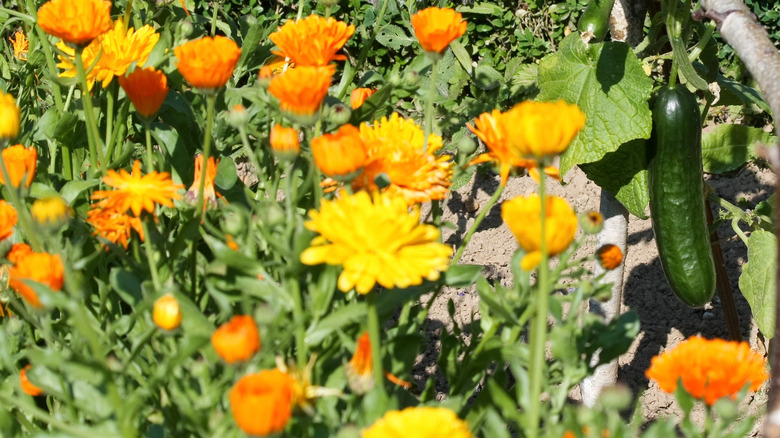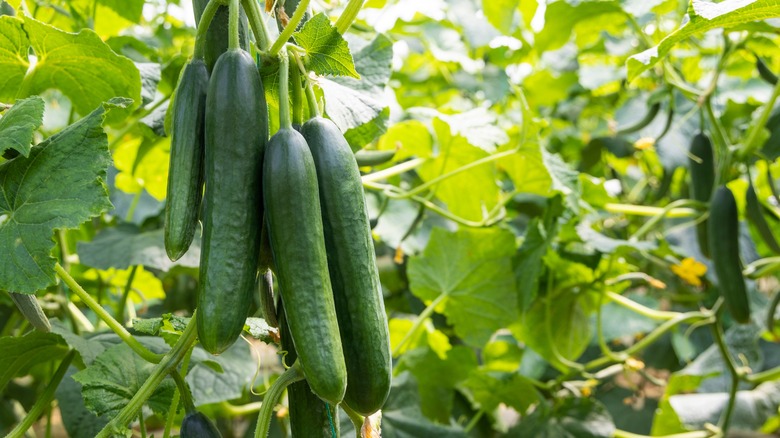Why Cucumbers And Marigolds Are The Perfect Companions In The Garden
Companion planting is a popular gardening technique that mainly involves planting certain plants, flowers, fruits, and vegetables close together so they can benefit each other and reach their full potential. This involves a plant utilizing certain qualities about its companion plant that will help to protect, nourish, or support it. Some plants work to repel pests, increase nitrogen in the soil, fend off weeds, provide support or shade, attract pollinators and good predators, or fight diseases.
Marigolds are particularly helpful for repelling pests. When marigolds are planted as a border in the garden or placed near the containers they grow in, the odor they give off is strong and unbearable for pests like cucumber beetles and thrips, making them an ideal companion plant for your cucumbers. Marigolds are particularly beloved because of their resilience as heat and drought-tolerant plants. This allows gardeners to care for the rest of their plants without having to fuss over their brightly colored marigolds.
How marigolds benefit cucumbers
Cucumbers are best planted in spring, once temperatures reach 70 degrees Fahrenheit. Straw mulch can be used after planting, which will help your plants maintain good temperature and moisture and will protect your cucumbers from slugs and snails that aren't fans of the rough texture. Because cucumbers can grow up to 6 feet tall, properly space your cucumbers when planting so they're not overcrowded and each of them has proper air circulation. This will help with growth and preventing fungal diseases from trapped moisture. Cucumbers are vulnerable to pests and diseases that are drawn to their shade and moisture. Some of these include pests like cucumber beetles, aphids, cutworms, and cabbage loopers, as well as anthracnose fungal disease.
Marigolds are potent flowers. Besides their strong fragrance which works to repel pests, their high pollen content attracts pollinators like bees and butterflies. However, this pollen has a downside because it can trigger reactions like sinusitis and asthma attacks, so take care when planting. Marigolds can attract good predatory insects to your garden that will feed off the pests that destroy your crops. They are often used as a trap crop against pests like tomato borers and thrips . Aside from cucumbers, marigolds have been known to enhance growth and ward off pests for other vegetables like broccoli, eggplants, basil, potatoes, kale, and tomatoes.
Other companion plants for cucumbers
Cucumbers are known to have other companion plants that serve different purposes in the growth and health of the vegetable. Corn can work as a trellis for vining cucumbers that use the long stalks as support. Dill and sunflowers are good at attracting insects that feed off of pests, and cucumbers also work well with peas which nourish the soil by increasing nitrogen which improves growth. Because cucumber roots don't go deep into the soil, they make great companion plants for root vegetables like radishes, maximizing your gardening space.
Despite their versatility, cucumbers don't pair well with all other plants. A common mistake you don't want to make when growing cucumbers is to plant them with plants that will jeopardize the health of your garden. Despite being a root vegetable, potatoes don't pair well with cucumbers because the moisture content in both vegetables makes them susceptible to fungal diseases, and planting them together increases that risk. Similarly, melons are vulnerable to the same kind of pests as cucumbers, so planting them together will risk turning your garden into a pest paradise.


